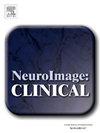Medulla oblongata dominated synaptic density network degeneration in amyotrophic lateral sclerosis
IF 3.6
2区 医学
Q2 NEUROIMAGING
引用次数: 0
Abstract
Background
Amyotrophic lateral sclerosis (ALS) is a brain network disorder closely associated with synaptic loss in the upper and lower motor neurons. However, the in vivo synaptic network changes and their progressive processes remain unclear. Here, we aim to investigate the synaptic density network connectivity and the likely sequences of synaptic loss in patients with ALS.
Methods
We examined data from 21 patients diagnosed with ALS and 25 sex- and age-matched healthy controls (HCs) who underwent PET imaging with the SV2A radioligand [18F]SynVesT-1. The individual synaptic density similarity network was constructed for each patient by calculating the similarity between interregional synaptic density distributions. The synaptic network connectivity changes were investigated, followed by an examination of the local synaptic density in regions that showed significant network alterations. Finally, we constructed the voxel-wise and ROI-wise causal synaptic covariance network (cSCN) by applying Granger causality analysis. This allowed us to identify the sequence of synaptic loss in these brain regions.
Results
We observed an overall decrease in synaptic density network connectivity in ALS patients compared to controls, with the highest nodal degree in the right medulla oblongata. Specifically, the reduced connections were dominantly between the medulla oblongata and the striatum, frontal lobe, occipital lobe, as well as between the striatum and the frontal lobe, occipital lobe. Furthermore, patients with ALS displayed significantly synaptic loss in those brain regions. The cSCN analyses showed that as the disease progresses, the cortical synaptic loss sequences of ALS extend from the medulla oblongata to the regions including the striatum, frontal lobe, occipital lobe, and parietal lobe.
Conclusions
These findings suggest that synaptic density network degeneration in ALS may follow a bottom-up transmission pattern, primarily involving in the medulla oblongata-striatum-neocortex network, which have the potential to capture new network-based targets for clinical therapy in the progression of ALS.
肌萎缩性侧索硬化症中延髓主导的突触密度网络变性
肌萎缩性侧索硬化症(ALS)是一种与上下运动神经元突触丧失密切相关的脑网络疾病。然而,体内突触网络的变化及其进展过程尚不清楚。在此,我们旨在研究ALS患者突触密度、网络连通性和突触丢失的可能序列。方法研究了21例ALS患者和25例性别和年龄匹配的健康对照(hc),他们接受了SV2A放射配体[18F]SynVesT-1的PET成像。通过计算区域间突触密度分布的相似性,构建个体突触密度相似网络。研究了突触网络连通性的变化,随后检查了显示显着网络改变的区域的局部突触密度。最后,运用格兰杰因果分析,构建了体素型和roi型因果突触协方差网络(cSCN)。这使我们能够确定这些大脑区域突触丧失的顺序。结果与对照组相比,ALS患者的突触密度网络连通性总体下降,其中右侧延髓的节度最高。具体来说,延髓与纹状体、额叶、枕叶以及纹状体与额叶、枕叶之间的连接主要减少。此外,ALS患者在这些脑区表现出明显的突触丧失。cSCN分析显示,随着疾病的进展,ALS的皮质突触丧失序列从延髓延伸到纹状体、额叶、枕叶和顶叶等区域。结论ALS的突触密度网络退化可能遵循自下而上的传递模式,主要涉及延髓-纹状体-新皮质网络,这可能为ALS的临床治疗提供新的基于网络的靶点。
本文章由计算机程序翻译,如有差异,请以英文原文为准。
求助全文
约1分钟内获得全文
求助全文
来源期刊

Neuroimage-Clinical
NEUROIMAGING-
CiteScore
7.50
自引率
4.80%
发文量
368
审稿时长
52 days
期刊介绍:
NeuroImage: Clinical, a journal of diseases, disorders and syndromes involving the Nervous System, provides a vehicle for communicating important advances in the study of abnormal structure-function relationships of the human nervous system based on imaging.
The focus of NeuroImage: Clinical is on defining changes to the brain associated with primary neurologic and psychiatric diseases and disorders of the nervous system as well as behavioral syndromes and developmental conditions. The main criterion for judging papers is the extent of scientific advancement in the understanding of the pathophysiologic mechanisms of diseases and disorders, in identification of functional models that link clinical signs and symptoms with brain function and in the creation of image based tools applicable to a broad range of clinical needs including diagnosis, monitoring and tracking of illness, predicting therapeutic response and development of new treatments. Papers dealing with structure and function in animal models will also be considered if they reveal mechanisms that can be readily translated to human conditions.
 求助内容:
求助内容: 应助结果提醒方式:
应助结果提醒方式:


